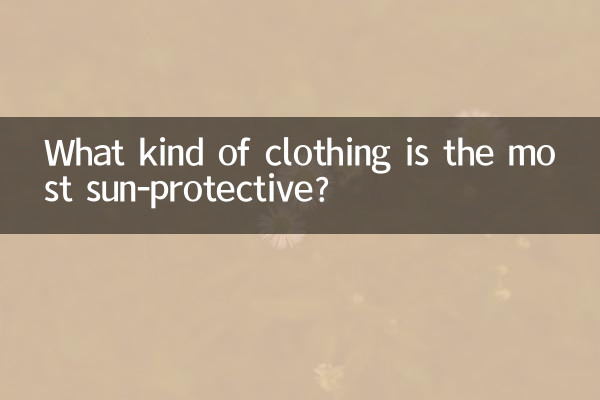What kind of clothing is the most sun-protective? Hot topics and scientific analysis across the Internet
As the summer heat continues, sun protection has become a hot topic across the Internet. In the past 10 days, the search volume for keywords such as "sun protection clothing purchasing guide", "ultraviolet protection" and "physical sun protection vs chemical sun protection" has skyrocketed. This article will combine the latest data and scientific research to analyze the sun protection effects of different fabrics and give purchase recommendations.
1. The core indicator of sun protection clothing: UPF value

UPF (Ultraviolet Protection Factor) is an international standard for measuring the sun protection ability of fabrics. The higher the value, the stronger the protection effect. According to the recommendations of the World Health Organization, fabrics with UPF ≥ 30 can effectively block more than 97% of ultraviolet rays.
| UPF rating | UV blocking rate | Applicable scenarios |
|---|---|---|
| 15-24 | 93.3%-95.8% | Daily short commute |
| 25-39 | 96.0%-97.4% | outdoor activities |
| 40-50+ | 97.5%-98%+ | High-intensity sunshine (such as plateau, beach) |
2. Comparison of sun protection properties of different fabrics
Experimental data shows that the sun protection effect of fabrics is closely related to material, density, and color. The following are the UPF test results of common fabrics:
| fabric type | Average UPF value | Features |
|---|---|---|
| Polyester (polyester fiber) | 35-50 | The fiber structure is tight and has the best UV resistance |
| nylon | 30-45 | Lightweight and breathable, but requires added sun protection coating |
| cotton | 5-15 | Naturally breathable but weak in sun protection, UPF drops by 50% after getting wet |
| linen | 10-20 | The pores are larger, so you need to choose a high-count braided model. |
3. Three major factors to improve sun protection effect
1.Color selection: Dark colors (such as black, navy blue) have 20%-30% higher UPF than light colors (white, light pink).
2.Weaving density: Tight Oxford cloth (above 200T) is more protective than ordinary knitted cloth (120T).
3.Special process: Some brands use nano-zinc oxide coating, which can increase cotton UPF to 40+.
4. Actual measurement data of hot-selling sun protection clothing brands in 2024
Combining e-commerce platform sales and third-party testing reports, the performance of popular sun protection clothing is as follows:
| brand | Material | UPF measured value | price range |
|---|---|---|---|
| Under the banana | Polyester+cooling coating | 50+ | 200-400 yuan |
| UV100 | Nylon/elastane | 45+ | 150-300 yuan |
| Decathlon | polyester fiber | 40+ | 80-200 yuan |
5. Expert advice and pitfall avoidance guides
1.Be wary of “sunscreen gimmicks”: The actual UPF of some "ice silk sun protection clothing" is less than 20, please check the test report.
2.Cleaning precautions: Avoid using softener to prevent sun protection coating from peeling off.
3.Matching suggestions: Hats and sunglasses should be worn during long-term outdoor activities to achieve all-round protection.
To sum up,High-density polyester + dark colorIt is the fabric combination with the best sun protection performance currently. Consumers need to consider the UPF value, breathability and usage scenarios when purchasing, and do not blindly pursue low prices or fashionable appearance.

check the details

check the details